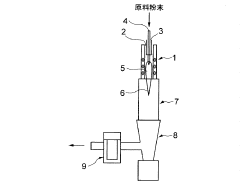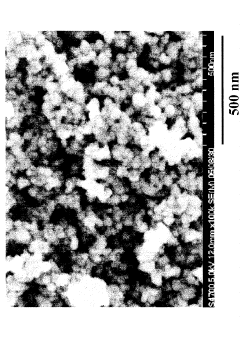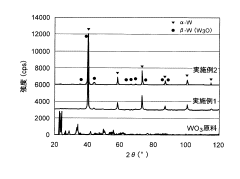How To Achieve Ultra-Fine Tungsten Particles?
Tungsten Particle Tech Evolution and Objectives
Tungsten particles have been a subject of intense research and development for decades, with their applications spanning various industries, from electronics to aerospace. The evolution of tungsten particle technology has been driven by the increasing demand for materials with superior properties, particularly in high-temperature and high-stress environments.
The journey towards ultra-fine tungsten particles began in the mid-20th century when the potential of tungsten's unique properties was first recognized. Initially, the focus was on producing tungsten powders for use in light bulb filaments and welding electrodes. As technology progressed, the need for finer particles became apparent, leading to the development of new production methods.
In the 1970s and 1980s, significant advancements were made in powder metallurgy techniques, allowing for the production of tungsten particles in the micron range. This breakthrough opened up new possibilities in the field of sintered tungsten products, improving their density and mechanical properties.
The 1990s saw a shift towards nanoscale tungsten particles, driven by the emerging nanotechnology revolution. Researchers began exploring chemical vapor deposition (CVD) and solution-based synthesis methods to achieve particle sizes below 100 nanometers. These ultra-fine particles exhibited enhanced properties, including increased surface area and improved sintering behavior.
As we entered the 21st century, the objectives for tungsten particle technology became more refined and ambitious. The primary goal shifted towards developing scalable and cost-effective methods for producing ultra-fine tungsten particles with controlled size, shape, and purity. This aim was fueled by the growing demand in advanced applications such as thermal management materials, radiation shielding, and additive manufacturing.
Current technological objectives focus on achieving particle sizes below 50 nanometers while maintaining narrow size distributions. Researchers are also working on improving the dispersion and stability of these ultra-fine particles in various matrices, enhancing their processability and performance in composite materials.
Another critical objective is the development of environmentally friendly and energy-efficient production methods. Traditional tungsten powder production often involves energy-intensive processes and the use of hazardous chemicals. New approaches, such as plasma-based synthesis and green chemistry routes, are being explored to address these concerns and meet sustainability goals.
Looking ahead, the field of ultra-fine tungsten particles is poised for further innovation. Objectives include the development of hierarchical structures combining nano and micro-scale features, as well as the integration of tungsten particles with other nanomaterials to create hybrid systems with enhanced functionalities. Additionally, there is a growing interest in tailoring the surface chemistry of ultra-fine tungsten particles to improve their compatibility with various matrix materials and expand their application range.
Market Demand for Ultra-Fine Tungsten Particles
The market demand for ultra-fine tungsten particles has been steadily increasing across various industries due to their unique properties and versatile applications. In the electronics sector, these particles are crucial for manufacturing high-performance capacitors, microchips, and advanced semiconductor devices. The miniaturization trend in electronics has further boosted the demand for ultra-fine tungsten particles, as they enable the production of smaller, more efficient components.
The aerospace and defense industries also contribute significantly to the market demand. Ultra-fine tungsten particles are essential in producing high-density alloys used in armor-piercing ammunition, radiation shielding, and aerospace components. The growing focus on lightweight yet strong materials in these sectors has led to increased adoption of tungsten-based alloys, driving the demand for ultra-fine particles.
In the medical field, ultra-fine tungsten particles find applications in radiation therapy equipment and medical imaging devices. The particles' high density and radiation-absorbing properties make them ideal for use in collimators and shielding materials. As the healthcare industry continues to advance, the demand for more precise and effective medical equipment is expected to fuel the market for ultra-fine tungsten particles.
The automotive industry is another significant consumer of these particles. They are used in the production of wear-resistant coatings for engine components, improving fuel efficiency and reducing emissions. With the global push towards more environmentally friendly vehicles, the demand for ultra-fine tungsten particles in this sector is projected to grow.
The energy sector, particularly in oil and gas exploration, utilizes ultra-fine tungsten particles in drilling equipment and wear-resistant coatings. As exploration activities expand into more challenging environments, the need for durable and high-performance materials increases, driving the demand for these particles.
Market analysis indicates that the global ultra-fine tungsten particle market is expected to experience substantial growth in the coming years. Factors such as technological advancements, increasing industrial applications, and the growing demand for high-performance materials are driving this expansion. The Asia-Pacific region, particularly China, is anticipated to be a major contributor to market growth due to its robust manufacturing sector and increasing investments in advanced technologies.
However, challenges such as the high cost of production and environmental concerns associated with tungsten mining and processing may impact market growth. Despite these challenges, ongoing research and development efforts aimed at improving production efficiency and exploring sustainable sourcing methods are expected to mitigate these issues and support continued market expansion.
Current Challenges in Ultra-Fine Tungsten Production
The production of ultra-fine tungsten particles faces several significant challenges that hinder widespread industrial adoption and limit the potential applications of this advanced material. One of the primary obstacles is the high energy consumption required for traditional manufacturing processes. Conventional methods, such as mechanical milling or chemical vapor deposition, often demand substantial energy inputs, making large-scale production economically unfeasible and environmentally unsustainable.
Another critical challenge lies in achieving consistent particle size distribution and morphology. Ultra-fine tungsten particles are highly sensitive to processing conditions, and even minor variations can lead to significant differences in particle characteristics. This inconsistency poses difficulties in quality control and can result in batch-to-batch variations, which is unacceptable for many high-precision applications in industries such as aerospace and electronics.
The tendency of ultra-fine tungsten particles to agglomerate presents a further complication. Due to their high surface energy and small size, these particles naturally cluster together, forming larger aggregates. This agglomeration not only affects the final product's properties but also complicates handling and processing steps, potentially leading to non-uniform distribution in composite materials or coatings.
Oxidation susceptibility is another major concern in ultra-fine tungsten production. The high surface area-to-volume ratio of these particles makes them extremely reactive with oxygen, even at room temperature. This reactivity can lead to the formation of tungsten oxides on the particle surface, altering their properties and potentially compromising their performance in various applications.
Safety considerations also pose significant challenges in the production process. Ultra-fine tungsten particles can be pyrophoric, meaning they may spontaneously ignite when exposed to air. This property necessitates stringent safety protocols and specialized handling equipment, adding complexity and cost to the manufacturing process.
Lastly, the scalability of production methods remains a substantial hurdle. While laboratory-scale synthesis of ultra-fine tungsten particles has shown promising results, translating these processes to industrial-scale production while maintaining particle quality and economic viability is extremely challenging. This scaling issue is particularly pronounced for newer, more advanced production techniques such as plasma-based methods or solution-phase synthesis approaches.
Existing Ultra-Fine Tungsten Production Methods
01 Nano-scale tungsten particles
Tungsten particles in the nanometer range are utilized for various applications. These nano-scale particles typically have sizes ranging from 1 to 100 nanometers. The small size of these particles contributes to unique properties and enhanced performance in specific applications.- Nano-scale tungsten particles: Tungsten particles at the nanometer scale, typically ranging from 1 to 100 nm, are used in various applications due to their unique properties. These nanoparticles offer improved sintering characteristics, enhanced mechanical properties, and increased surface area-to-volume ratio compared to larger particles.
- Micron-sized tungsten particles: Tungsten particles in the micron range, typically from 1 to 100 microns, are commonly used in powder metallurgy, thermal spray coatings, and as reinforcements in composite materials. These particles provide a balance between surface area and bulk properties, making them suitable for a wide range of industrial applications.
- Particle size distribution control: Controlling the particle size distribution of tungsten powders is crucial for achieving desired material properties. Techniques such as sieving, air classification, and selective agglomeration are employed to obtain specific size ranges or narrow distributions, which can significantly impact the final product's performance.
- Ultrafine tungsten particles: Ultrafine tungsten particles, typically smaller than 100 nm, are produced through advanced synthesis methods such as chemical vapor deposition or plasma processes. These particles exhibit enhanced sinterability, improved mechanical properties, and unique catalytic activities, making them valuable in advanced materials and nanotechnology applications.
- Particle size measurement techniques: Accurate measurement of tungsten particle sizes is essential for quality control and research purposes. Various techniques are employed, including laser diffraction, dynamic light scattering, electron microscopy, and BET surface area analysis. These methods provide complementary information on particle size, shape, and distribution.
02 Micron-sized tungsten particles
Tungsten particles in the micron size range are commonly used in various industries. These particles typically have sizes ranging from 1 to 100 micrometers. The micron-sized particles offer a balance between surface area and bulk properties, making them suitable for applications such as thermal management and radiation shielding.Expand Specific Solutions03 Particle size distribution control
Controlling the particle size distribution of tungsten particles is crucial for achieving desired properties in final products. Various methods are employed to obtain a narrow or specific particle size distribution, including mechanical milling, chemical vapor deposition, and plasma processing techniques.Expand Specific Solutions04 Ultrafine tungsten particles
Ultrafine tungsten particles, typically smaller than 100 nanometers, are produced for specialized applications. These particles exhibit enhanced properties due to their extremely small size, including increased surface area and reactivity. Production methods for ultrafine particles often involve advanced techniques such as plasma synthesis or chemical reduction.Expand Specific Solutions05 Particle size measurement techniques
Various techniques are employed to measure and characterize the size of tungsten particles. These methods include laser diffraction, dynamic light scattering, electron microscopy, and sedimentation analysis. Accurate particle size measurement is essential for quality control and ensuring the particles meet the required specifications for specific applications.Expand Specific Solutions
Key Players in Ultra-Fine Tungsten Industry
The competition landscape for achieving ultra-fine tungsten particles is characterized by a mature market with significant growth potential. The industry is in a phase of advanced development, with major players like ULVAC, Inc., Toshiba Corp., and Sumitomo Metal Mining Co. Ltd. leading technological advancements. The market size is substantial, driven by increasing demand in electronics, aerospace, and advanced materials sectors. Technological maturity is high, with companies such as Novellus Systems, Inc. and Lam Research Corp. contributing to sophisticated production methods. Research institutions like the University of Science & Technology Beijing and the National Institute for Materials Science IAI are pushing boundaries in particle size reduction and control, indicating ongoing innovation in this field.
ULVAC, Inc.
Sumitomo Metal Mining Co. Ltd.
Core Innovations in Particle Size Reduction
- Irradiating an electron beam with an intensity of 10^8 to 10^9 A/m^2 (10^23 to 10^24 e/cm^2·sec) on a W oxide particle in a high vacuum atmosphere to debond W atoms from the oxide, using an amorphous carbon support film to obtain ultra fine W particles with controlled particle diameters of 10 nm or less, which can exist as single particles or bonded bodies.
- A method involving vaporizing a tungsten compound with thermal plasma in a reducing atmosphere containing inert gas and hydrogen gas, followed by condensation and slow oxidation treatment, to produce ultrafine tungsten powder with a thin oxide film on its surface, ensuring high purity and uniform particle size.
Environmental Impact of Ultra-Fine Tungsten Production
The production of ultra-fine tungsten particles, while offering significant technological advantages, raises important environmental concerns that must be carefully addressed. The manufacturing process typically involves energy-intensive methods such as chemical vapor deposition or high-temperature hydrogen reduction, which can lead to substantial greenhouse gas emissions. These processes often require the use of hazardous chemicals and precursors, posing potential risks of environmental contamination if not properly managed.
Water usage and pollution are critical issues in ultra-fine tungsten production. The process may consume large quantities of water for cooling and purification, potentially straining local water resources. Additionally, wastewater from the production can contain toxic heavy metals and other pollutants, necessitating rigorous treatment before discharge to prevent harm to aquatic ecosystems and human health.
Air quality is another significant concern. The production of ultra-fine tungsten particles can release fine particulate matter and potentially harmful gases into the atmosphere. These emissions may contribute to local air pollution and pose respiratory health risks to workers and nearby communities if not adequately controlled through advanced filtration and scrubbing technologies.
The extraction and processing of tungsten ore, the raw material for ultra-fine particle production, also have substantial environmental impacts. Mining operations can lead to habitat destruction, soil erosion, and water contamination. The transportation of raw materials and finished products further contributes to the carbon footprint of the industry.
Waste management presents ongoing challenges. The production process generates various waste streams, including spent chemicals, contaminated filters, and off-spec materials. Proper disposal or recycling of these wastes is crucial to prevent environmental contamination and minimize the overall ecological footprint of ultra-fine tungsten production.
To mitigate these environmental impacts, the industry is increasingly focusing on developing more sustainable production methods. This includes research into less energy-intensive processes, the use of renewable energy sources, closed-loop water systems, and improved waste recovery and recycling techniques. Additionally, there is growing emphasis on life cycle assessments to comprehensively evaluate and reduce the environmental impact of ultra-fine tungsten particles throughout their production, use, and disposal phases.
Regulatory compliance and voluntary industry initiatives play crucial roles in driving environmental improvements. Stringent environmental standards, coupled with regular monitoring and reporting, are essential to ensure that ultra-fine tungsten production adheres to best practices for environmental protection. As the demand for these advanced materials continues to grow, balancing technological progress with environmental stewardship remains a critical challenge for the industry.
Quality Control and Characterization Techniques
Quality control and characterization techniques play a crucial role in the production of ultra-fine tungsten particles. These methods ensure the consistency, purity, and desired properties of the final product. Particle size distribution analysis is a fundamental technique used to verify the achievement of ultra-fine dimensions. Laser diffraction and dynamic light scattering are commonly employed for this purpose, providing accurate measurements of particle sizes ranging from nanometers to micrometers.
X-ray diffraction (XRD) is another essential characterization method for ultra-fine tungsten particles. It allows for the determination of crystal structure, phase composition, and crystallite size. XRD patterns can reveal the presence of any impurities or unwanted phases, ensuring the purity of the tungsten particles. Additionally, the Scherrer equation can be applied to XRD data to estimate the average crystallite size, which is particularly useful for nano-sized particles.
Scanning electron microscopy (SEM) and transmission electron microscopy (TEM) are indispensable tools for visualizing the morphology and structure of ultra-fine tungsten particles. SEM provides high-resolution images of particle surfaces and agglomeration tendencies, while TEM offers insights into the internal structure and lattice defects. These techniques are crucial for assessing the uniformity and shape of the particles, which can significantly influence their properties and applications.
Chemical composition analysis is vital to ensure the purity of ultra-fine tungsten particles. Inductively coupled plasma mass spectrometry (ICP-MS) and X-ray fluorescence (XRF) spectroscopy are commonly used for trace element analysis, detecting impurities at parts per million levels. These methods help maintain strict quality control by identifying and quantifying any contaminants that may affect the performance of the particles.
Surface area measurement, typically performed using the Brunauer-Emmett-Teller (BET) method, is another critical characterization technique. The specific surface area of ultra-fine tungsten particles is directly related to their size and can significantly influence their reactivity and sintering behavior. BET analysis provides valuable information for optimizing particle properties for specific applications.
Thermal analysis techniques, such as thermogravimetric analysis (TGA) and differential scanning calorimetry (DSC), are employed to study the thermal stability and phase transitions of ultra-fine tungsten particles. These methods can reveal important information about oxidation resistance, melting behavior, and potential phase transformations that may occur during processing or application.




